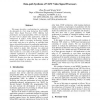Free Online Productivity Tools
i2Speak
i2Symbol
i2OCR
iTex2Img
iWeb2Print
iWeb2Shot
i2Type
iPdf2Split
iPdf2Merge
i2Bopomofo
i2Arabic
i2Style
i2Image
i2PDF
iLatex2Rtf
Sci2ools
ISSS
1998
IEEE
1998
IEEE
Data-Path Synthesis of VLIW Video Signal Processors
This paper describes a methodology for synthesizing the data-path of a Very Long Instruction Word (VLIW) based Video Signal Processor (VSP). Offering both performance and programmability, VSPs are important for their roles in digital video applications, which are omnipresent in today's world. Among many different architectures, VLIW is becoming increasingly popular and widely used due to its efficiency in exploiting high degree of parallelism inherent in multimedia applications. While architectural syntheses of embedded systems have been studied in depth, little literature has addressed similar issues for VLIW-based VSPs. Using an MPEG-2 video encoder as a case study, in this paper we present a combined application of trace-driven simulation and performance estimation in the data-path synthesis of a VLIW VSP. Results show that our estimations are quite precise and helpful, let alone that they are orders of magnitude faster than simulation.
Digital Video Applications | Hardware | ISSS 1998 | Very Long Instruction Word | Video Signal Processor |
| Added | 05 Aug 2010 |
| Updated | 05 Aug 2010 |
| Type | Conference |
| Year | 1998 |
| Where | ISSS |
| Authors | Zhao Wu, Wayne Wolf |
Comments (0)

